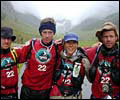|
|
| ||||||||||||||
October 2, 2001 Results
With the Swiss mountains painting the backdrop for the first annual Discovery Channel World Championship Adventure Race, the course, offering competitors hiking, mountain biking, canyoneering, climbing, and rafting, was expected to represent the best adventure racing had to offer.
Having completed a day of required skill testing and last-minute preparations under pouring rain and lightning, possible precursors to conditions during the next week, the race began on a beautiful day high in the Swiss Alps. With all 41 teams on the starting line, the race began with a running sprint down the side of a 10,000-foot mountain glacier, the Piz Corvatsch glacier. This was the start of what would eventually become a race of attrition as over 80% of the "world class" field would not make the full six days. Having successfully run down the first of what became uncountable descents and ascents, either on foot or mountain bike, teams settled into their "race pace" for the relentless terrain ahead. Late on the first day came the first sign of things to come. Heading into one of the checkpoints, all the teams, including ours, Team McGuire, were told to take a specific route around the mountains after organizers experienced problems with some teams taking another route. These wayward teams were getting stuck on high ridges and rocks and were not able to descend without significant danger. This alternate route was a 1000-foot slog up the side of a glacier where one missed step would cause you to tumble the 1000 feet to the bottom. This became only the first of many course changes attributable to weather or other unforeseen obstacles. Having overcome this first obstacle, teams continued to traverse through the mountains toward the next 32 checkpoints. Having mapped out the course the night before the race start, all teams knew what lay ahead, but this was from a map's perspective,and we had no idea what was actually awaiting us until the moment we were physically there. Looking at the race as a whole in the order we would be doing the events, we would be hiking, canyoneering, mountain biking, rafting, biking, hiking, biking, hiking, biking, hiking, and biking. Looking more like a hiking and biking race, rather than a race of many disciplines. With this prospect ahead and the pain associated with the first day of racing, a 35-mile mountain trek, 10 teams dropped out in the first 24 hours. This is an unusually early exit for so many teams and even more surprising since this race was supposed to be representing the best the adventure racing world had to offer. As the racing continued, teams made their way through the mountains and canyons to the first transition area. Unfortunately on the canyoneering section, due to an extreme change of weather and lack of appropriate equipment, many were stricken with hypothermia, with some cases so extreme that teams' races would be over within hours. Organizers soon closed this section of the course to the remaining teams. Teams that had made it through the first 24 hours headed on to the mountain biking discipline. Despite cooperative weather for the first day of racing, this would not be the case over the next few days of hiking and mountain biking, with high altitude, rain, snow and cold temperatures forcing teams to forge their way on trails covered with snow and ice, into areas that would become more dangerous as the weather deteriorated and the racers become more fatigued. As the hours wore on and the many checkpoints and transitions came and went, the nature of the course took its toll on racers. With teams continuously fighting the ascents and descents, and the deterioration of the weather, it was only a matter of time before many of the most seasoned, expedition-level racers would call it quits. But the race was littered with some of the most awesome terrain imaginable. The stunning peaks of the Alps could be seen from any standpoint. The unfortunate part of this scene being that these stunning peaks would ultimately need to be traversed by the racers. The beauty would suddenly be overcome by pain and ultimately disgust, as these mountains would ultimately make each and every one of us feel the anguish of the course that lay ahead. All told the course held over 62,000 feet of elevation gain. As the days rolled by the course took its toll on all but nine teams and even these teams would not complete the full course that had been laid out by race organizers. Due to weather and time constraints, the race course was changed multiple times in order to ensure at least a few teams would actually cross the finish line by the required 5pm cut off on Saturday, September 8. The two most significant of these changes were the closing of the climbing section due to rain and lightning, and the partial closing of the second hiking/mountaineering section due to snow. It was without a doubt a tough course, but was it a course that truly gave world class adventure racers the challenge they were looking for? This will remain the question until the next world championship adventure race or at least until the next expedition level adventure race that deems itself the toughest race around. —Greg Thomas, Adventure Racing Correspondent SEE ALSO: The A-Files | Desert Dash Schedule |
|
|||||||||||||
© 2001 Vertical Media Group, Inc. Seattle, WA.

